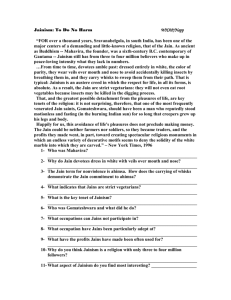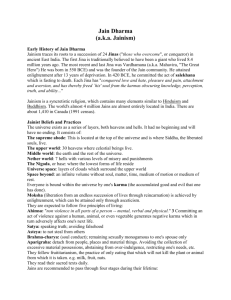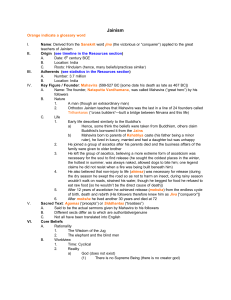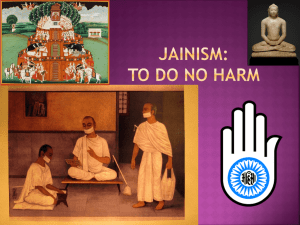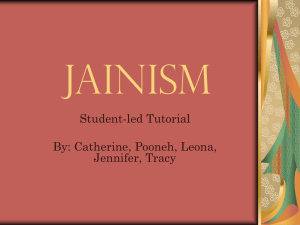Jainism today
advertisement
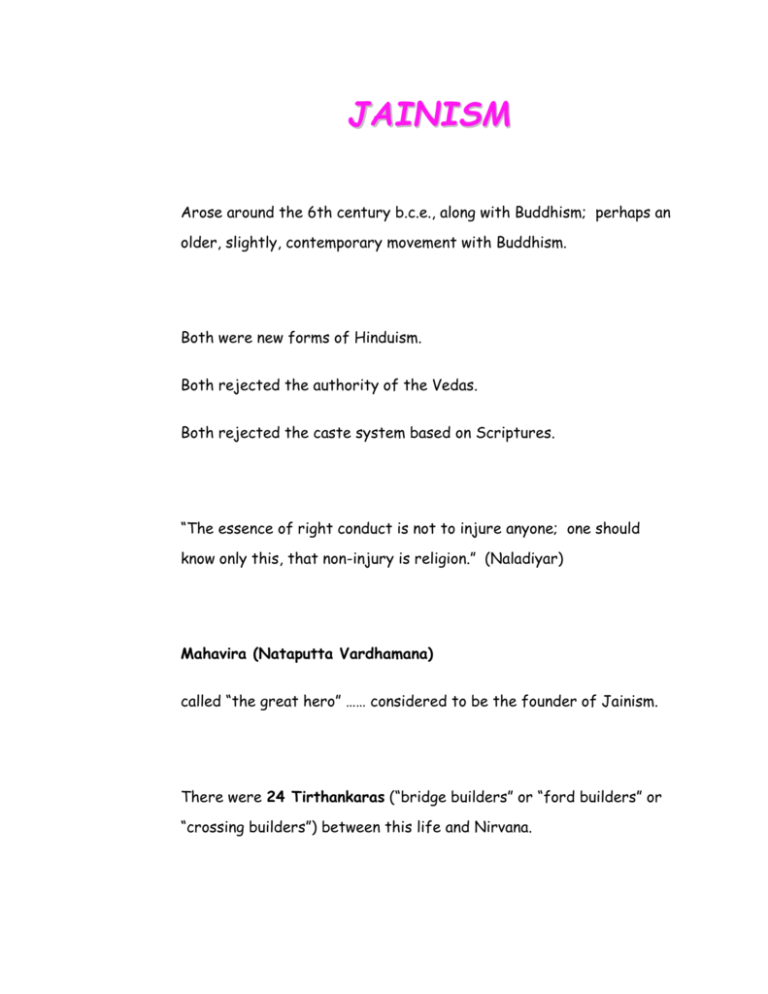
JAI NISM Arose around the 6th century b.c.e., along with Buddhism; perhaps an older, slightly, contemporary movement with Buddhism. Both were new forms of Hinduism. Both rejected the authority of the Vedas. Both rejected the caste system based on Scriptures. “The essence of right conduct is not to injure anyone; one should know only this, that non-injury is religion.” (Naladiyar) Mahavira (Nataputta Vardhamana) called “the great hero” …… considered to be the founder of Jainism. There were 24 Tirthankaras (“bridge builders” or “ford builders” or “crossing builders”) between this life and Nirvana. Mahavira was number 24... the last one. He lived in the years (not known with certainty) 599-527 BCE, or some say 540-468 (John Hutchison), which is close to the dates given for the Buddha (560-480). He was a contemporary of Gautama, Confucius, Lao Tzu, Jeremiah, Ezekiel, Isaiah, and the Greek philosophers .... “the Axis Age” or “the Axis Time” as Jaspers has called it (the 7th and 6th centuries BCE). Mahavira’s life: He was from a wealthy family in northern India ... married, had a daughter, riches and position. But, like the Buddha, he was unhappy with this life of shelter and ease. When his parents died (starved themselves to death), he joined a group of ascetics following Parshva (a former Tirthankara, or fordfinder). He tore out his hair and beard and left his life.. wealth and wife, etc., and went to the forest; joined the ascetics. He became the most extreme of any of them. This is known as the practice of tapas... asceticism to achieve liberation or salvation. Also, he practiced ahimsa to the extreme... non-injury to living things. He avoided hurting insects. He swept the path in front of him with a small broom. Strained his drinking water to avoid drinking bugs. He ate only left over food. He let dogs bite him, and he let people build a fire under him! (they were torturing him for fun… yet he remained unperturbed in his quest for salvation). This went on for 12 years ... his quest for salvation. Then he arrived at moksha, at nirvana! He was then known as a “Jain”... a conqueror of the forces and miseries of life. He lived, taught, and preached another 30 years, dying at the age of 72. Jain doctrines: 1. reincarnation & karma (any action at all builds up bad karma; so avoid all action. 2. dualism: jiva and ajiva soul/life eternal/good versus matter/the lifeless/ and evil People are souls “encased in matter”. Flesh is evil …… it encases the soul. therefore, ascetic response is called for... torment the flesh! The individual must free himself... cat-hold view of salvation, i.e., the tariki view... self effort (not the grace of god or of the cosmos) is the only thing that can free you. There is no help from outside oneself. The gods are of little consequence… they are also trapped in this universe. Matter is eternal; there is no creator god, transcending and superior to the cosmos. The gods are simply creatures of another dimension, working on their own salvation. These gods cannot help us. Prayer, worship, sacrifice, etc., are of no use. Jainism is essentially atheistic. (“Transpolytheistic atheism” as Hutchison says!). Jainism in practice two groups : 1. majority ... remain in the home-stage 2. monks … ascetic rigors; these are the role models for all Jains. five vows: 1. ahimsa 2. speak the truth 3. honesty (don’t steal) 4. no sex (renounce women as the greatest temptations and snares) 5. renounce all attachments which bind you to life. Jain scriptures …… called Agamas (precepts) or Siddhantas (treatises). Many are not translated into English. Jain sects Divisions arose by 80 CE. A more liberal view of Mahavira’s teachings is held by the division known as the Svetambara (white clad)... in northern India. The monks wear white clothing; allow women into the religion and monasteries; allow women the possibility of salvation. Digambaras (sky clad) Monks in this division are almost naked; women have no chance of salvation... (too great a temptation); women can’t even enter the monastery or temple. (In 1473 ... Sthanakavasi opposed to temples, and to idols, etc.) Jainism today over 2,600,000 adherents... Bombay is the center of Jainism. The sacredness of life... prohibits them from entering many occupations … even farming is disallowed! So, trade, or commerce is their common choice of occupation. They venerate the 24 Tirthankaras. There are over 40,000 temples of great beauty in India. They employ meditation, hymns, and prayers, too! I.e., Jain practice is not always consistent with the extreme asceticism taught in their basically philosophical, or non-theistic approach to salvation.

